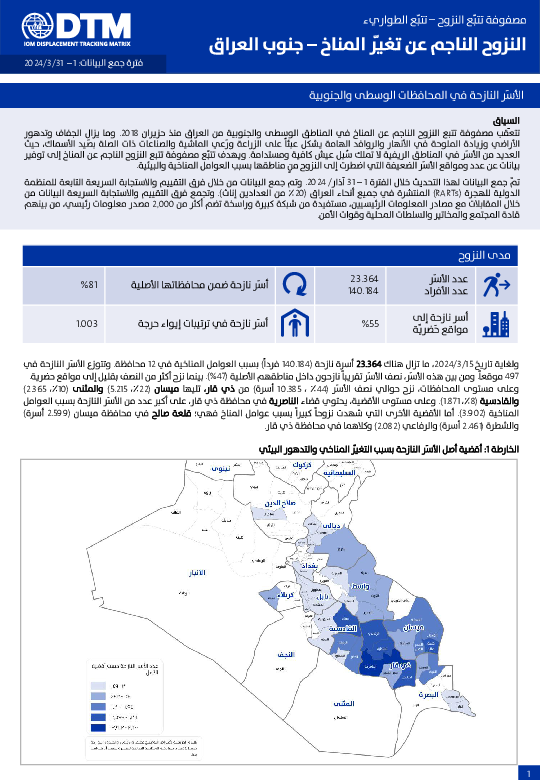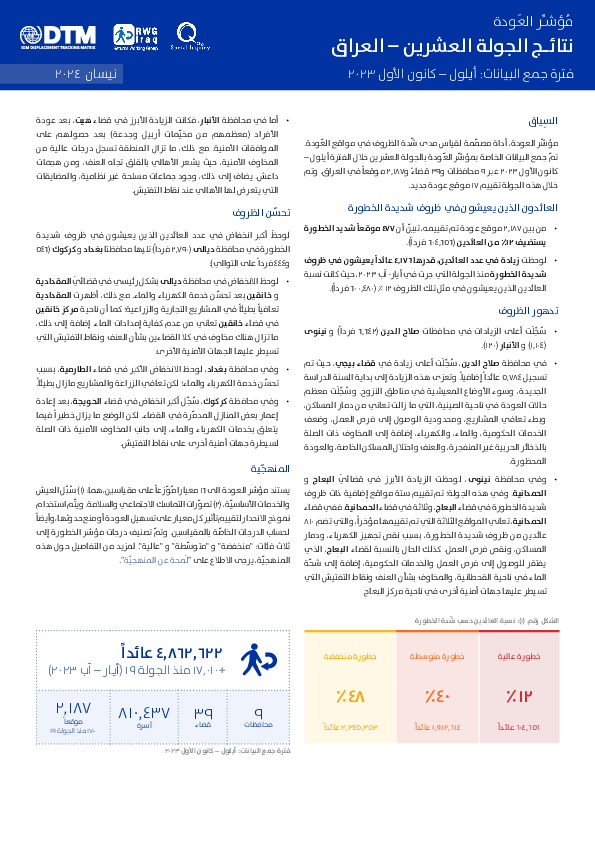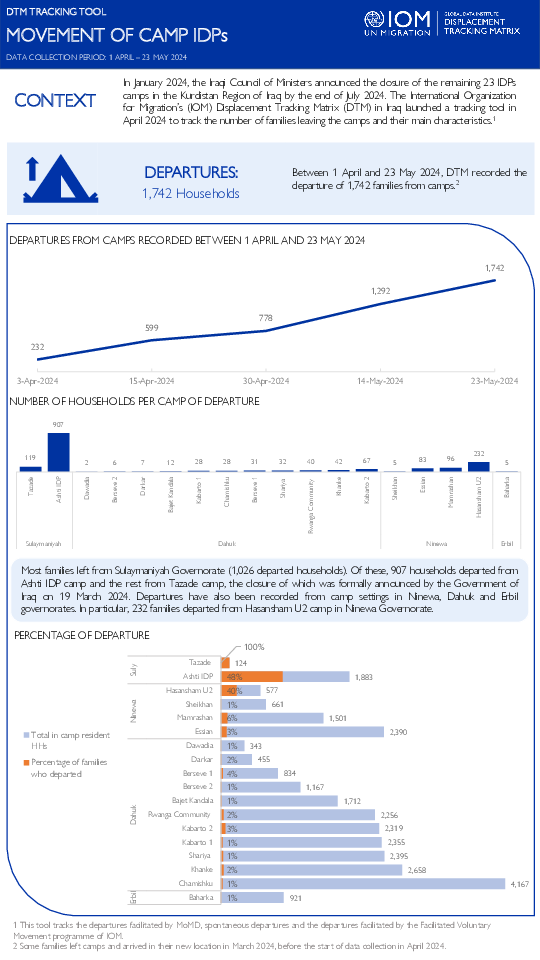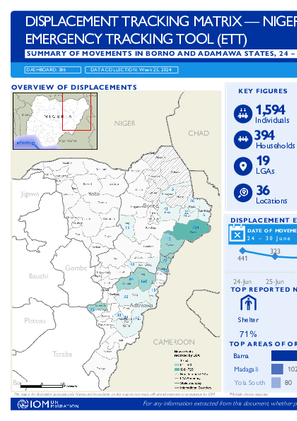-
Countries
-
Data and Analysis
-
Special Focus
-
Crisis Responses
Internal displacement
Domain host
displacement.iom.int

Contact
iomnigeriadtm@iom.int
Language
English
Location
Nigeria
Period Covered
Jul 01 2024
Jul 07 2024
Activity
- Mobility Tracking
- Event Tracking
On 01, 03 and 04 July 2024, communal clashes occured in the community of Aila in Egba ward of Agatu local government area (LGA), armed bandits attacked the community of Samco Community in Borikyo ward of Ukum LGA and heavy rainfall occurred in the community of Achusa Market in Bar ward of Makurdi LGA all in Benue State. There were reports of 78 injuries and 28 fatalities. The attacks displaced 618 individuals in 135 households from Aila community to Obagaji host community in Obagaji ward. The affected individuals included 851 children, 387 women and 297 men.
On 04 and 06 July 2024, armed bandits attacked Model Primary School Camp in Gwadabawa ward of Gwadabawa LGA in Sokoto State and a communal clash occurred in the community of Sabuwar Unguwa in Wakili Kudu 3 ward of Katisna LGA in Katsina State. There were reports of 39 injuries and six fatalities. The affected individuals included 1,069 children, 549 women, and 304 men.
Of all the needs identified, food, non-food items (NFI), WASH, and transport were the most prevalent. Other needs included shelter, psychosocial support, and health.
Following these events, DTM (Displacement Tracking Matrix) field staff conducted rapid assessments to inform the humanitarian community and Government/partners, and to enable a targeted response.
Nigeria’s north-central and north-west zones are afflicted with a multi-dimensional crisis. Long-standing tensions between ethnic and religious groups often result in attacks and banditry or hirabah. These attacks involve kidnapping and grand larceny along major highways by criminal groups. During the past years, the crisis accelerated and has resulted in widespread displacement across the north-central and north-west regions.

Contact
DTM Iraq, IraqDTM@iom.int
Language
Arabic
Location
Iraq
Period Covered
Mar 01 2024
Mar 31 2024
Activity
- Mobility Tracking
Climate-Induced Displacement report (Arabic translation) provides quarterly updates on the number and locations of vulnerable families forced to be displaced due to climatic and environmental factors.

Contact
DTM Iraq, IraqDTM@iom.int
Language
Arabic
Location
Iraq
Period Covered
Sep 01 2023
Dec 31 2023
Activity
- Survey
- Return Intention
- Mobility Tracking
- Baseline Assessment
he Return Index report (Arabic translation) provides triannual updates on the severity of conditions in locations of return using 16 indicators across two domains: (1) livelihoods and basic services, and (2) social cohesion and safety perceptions.

Contact
DTM Iraq, IraqDTM@iom.int
Language
Arabic
Location
Iraq
Period Covered
Sep 01 2023
Dec 31 2023
Activity
- Mobility Tracking
- Baseline Assessment
The Master List report (Arabic translation) provides triannual updates on the number of IDPs and returnees in Iraq, recent movements and overall trends, shelter type, IDP areas of origin and areas of no return.

Contact
IraqDTM@iom.int
Language
English
Location
Iraq
Period Covered
Apr 01 2024
May 23 2024
Activity
- Mobility Tracking
- Event Tracking
In January 2024, the Iraqi Council of Ministers announced the closure of the remaining 23 IDPs camps in the Kurdistan Region of Iraq by the end of July 2024. The International Organization for Migration’s (IOM) Displacement Tracking Matrix (DTM) in Iraq launched a tracking tool in April 2024 to track the number of families leaving the camps and their main characteristics.

Contact
IraqDTM@iom.int
Language
English
Location
Iraq
Period Covered
Nov 01 2022
Nov 30 2022
Activity
- Survey
This factsheet on Sinjar District is an extension of the original pilot project in Ninewa Governorate aimed at assessing progress towards durable solutions to displacement for internally displaced persons (IDPs) and returnees in the governorates with the largest shares of displaced populations in Iraq. The goal is to understand where IDPs and returnees in Sinjar District stand five years after the end of the 2014–2017 crisis and in which aspects they are still struggling. In this respect, this project contributes to a broader discussion and Action Agenda around measuring progress towards solutions and determining the end of displacement. The assessment measured progress along five criteria stemmed from the Inter-Agency Standing Committee (IASC) Framework for Durable Solutions: 1) safety and security; 2) adequate standards of living; 3) access to livelihoods; 4) restoration of housing, land and property (HLP) and compensation and 5) personal documentation and participation.
Data collection for this factsheet took place in November 2022, across 3 sub-districts and 17 locations in the district of Sinjar. The focus of the study was on both IDPs and returnees within the district, including IDPs who are displaced within the district itself. Data were collected through IOM’s Rapid Assessment and Response Teams (RARTs), composed of over 73 staff members (40% of enumerators are female). They collected data through structured face-to-face interviews with a sample size of 310 IDP and 336 returnee households in Sinjar district.

Contact
iomnigeriadtm@iom.int
Language
English
Location
Nigeria
Period Covered
Jun 24 2024
Jun 30 2024
Activity
- Mobility Tracking
- Event Tracking
Between 24 and 30 June 2024, a total of 1,594 new arrivals were recorded at locations in Adamawa and Borno states. The new arrivals were recorded at locations in Askira/Uba, Bama, Dikwa, Gwoza, Kaga, Kala Balge, Mafa, Monguno and Ngala Local Government Areas (LGAs) of the most conflict-affected Borno State, and in Fufore, Gombi, Hong, Lamurde, Madagali, Maiha, Michika, Song, Yola North and Yola South LGAs of Adamawa State.
ETT assessments identified the following movement triggers: military operations (548 individuals or 34%), poor living conditions (377 individuals or 24%), improved security (315 individuals or 20%), seasonal farming (175 individuals or 11%), family re-unification (90 individuals or 6%), fear of attack (42 individuals or 2%), camp closure (31 individuals or 2%) and access to humanitarian support (16 individuals or 1%).

Contact
DTM Yemen, iomyemendtm@iom.int
Language
English
Location
Yemen
Period Covered
Jun 30 2024
Jul 06 2024
Activity
- Mobility Tracking
- Event Tracking
IOM Yemen DTM’s Rapid Displacement Tracking (RDT) tool collects data on estimated numbers of households forced to flee on a daily basis from their locations of origin or displacement, allowing for regular reporting of new displacements in terms of estimated numbers, geography, and needs. It also tracks returnees who returned to their location of origin.
From 1 January to 6 July 2024, IOM Yemen DTM tracked 1,688 households (HH) (10,128 Individuals) who experienced displacement at least once.
Between 30 June and 6 July 2024, IOM Yemen DTM tracked 44 households (264 individuals) displaced at least once. The majority of people moved into/within the following governorates and districts:
- Ma’rib (31 HHs) – Al Abdiyah (15 HHs), Ma’rib City (8 HHs), Ma’rib (8 HHs) districts. Most displacements in the governorate originated from Ma’rib and Al Jawf.
- Ta’iz (7 HHs) – Jabal Habashi (5 HHs), Al Maafer (2 HHs) districts. Most displacements in the governorate originated from Ta’iz and Al Hodeidah.
- Al Hodeidah (4 HHs) – Hays (4 HHs) district. Most displacements in the governorate originated from Al Hodeidah and Ta’iz.
The majority of people moved from the following governorates and districts:
- Ma’rib (17 HHs) – Al Abdiyah (15 HHs), Bidbadah (1 HH), Harib (1 HH) districts.
- Ta’iz (8 HHs) – Maqbanah (5 HHs), Al Mudhaffar (1 HH), Jabal Habashi (1 HH) district.
- Al Hodeidah (7 HH) – Al Jarrahi (4 HHs), Al Qanawis (1 HH), Al Hawak (1 HH) districts.
IOM identified 22 additional households displaced in the previous reporting period, which covered 23 - 29 June 2024, in the governorates of Al Hodeidah (12 HHs), and Ma’rib (10 HHs). These figures have been added to the cumulative displacement total recorded since the beginning of the year.
Contact
DTM Yemen, iomyemendtm@iom.int
Location
Yemen
Activity
- Mobility Tracking
- Event Tracking
Period Covered
Jun 30 2024 -Jul 06 2024
From 1 January to 6 July 2024, IOM Yemen DTM tracked 1,688 households (HH) (10,128 Individuals) who experienced displacement at least once.
Between 30 June and 6 July 2024, IOM Yemen DTM tracked 44 households (264 individuals) displaced at least once. The majority of people moved into/within the following governorates and districts:
- Ma’rib (31 HHs) – Al Abdiyah (15 HHs), Ma’rib City (8 HHs), Ma’rib (8 HHs) districts. Most displacements in the governorate originated from Ma’rib and Al Jawf.
- Ta’iz (7 HHs) – Jabal Habashi (5 HHs), Al Maafer (2 HHs) districts. Most displacements in the governorate originated from Ta’iz and Al Hodeidah.
- Al Hodeidah (4 HHs) – Hays (4 HHs) district. Most displacements in the governorate originated from Al Hodeidah and Ta’iz.
The majority of people moved from the following governorates and districts:
- Ma’rib (17 HHs) – Al Abdiyah (15 HHs), Bidbadah (1 HH), Harib (1 HH) districts.
- Ta’iz (8 HHs) – Maqbanah (5 HHs), Al Mudhaffar (1 HH), Jabal Habashi (1 HH) district.
- Al Hodeidah (7 HH) – Al Jarrahi (4 HHs), Al Qanawis (1 HH), Al Hawak (1 HH) districts.
Population Groups
IDPs
Returnee (Previously Internally Displaced)
Survey Methodology
Unit of Analysis Or Observation
Admin Area 2
Type of Survey or Assessment
Household
Key Informant
Keywords
Geographical Scope Partial Coverage
Administrative boundaries with available data
The current dataset covers the following administrative boundaries

Contact
DTM Europe, DTMMediterranean@iom.int
Language
English
Location
Estonia
Period Covered
Apr 01 2024
Jun 30 2024
Activity
- Survey
The IOM’s Displacement Tracking Matrix (DTM) collected data through Surveys with Refugees in the Ukraine Response region from April to June 2024. In Estonia, a total of 654 surveys were collected. This report explores different aspects of the economic integration, employment profiles, and prospects of the adult respondents, specifically those who have an intention to stay or have already established themselves in the country. These individuals, who intend to stay in Estonia for the foreseeable future, are actively using their skills and resources to fully integrate into the host community. The report offers insights into their involvement in the labour market and detailing their experiences, needs, and intentions concerning employment in Estonia for the duration of their displacement.
Key findings:
- 85% of respondents were active, while 15% were inactive.
- Within the active population, 77% were employed and 23% were unemployed and looking for a job.
- Among the inactive population, 31% were on parental leave, 38% were retired, 20% were students and 11% were unemployed and not looking for a job.
- The majority of Ukrainian refugees depend on their income (81%) as the main source for daily expenses. However, over half (55%) of respondents rely on the authorities’ support, 15% on familial support and 6% on their savings.
- 24% did not attend any type of language classes for Estonian. However 41% are attending language classes at schools, over one quarter (23%) have classes with migration authorities and 29% receive online classes.
- The majority of respondents have not received any remittances (83%). 17% received 20 to 2,000 euros. Among recipients, 49% stated they have spent from 10 to 2,000 euros, whereas 51 per cent haven’t spent any of their remittances.
- Regarding entrepreneurship, many displaced Ukrainians are interested in opening their own business (28%). 3% already own their own business and 5% are unsure of wanting to. A significant proportion (64%) are not interested in having their own business.
- IOM’s DTM questioned respondents regarding workplace exploitation in Estonia, uncovering that 6% of those surveyed had encountered some degree of labour exploitation.
Pagination
- Previous page
- Page 63
- Next page
